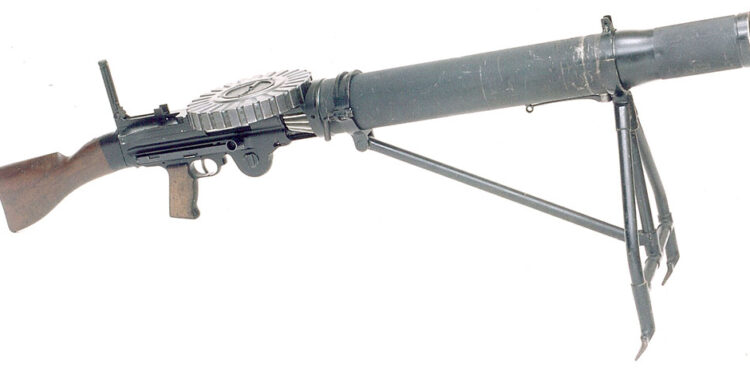By Robert G. Segel
The Lewis gun is the most recognized classic light machine gun in the world with an honorable battle record seeing service in two World Wars. It was invented by an American, Col. Isaac Newton Lewis. Col. Lewis was a United States Military Academy (West Point) graduate (1884) and spent twenty-five years in the United States Army assigned primarily to Coastal Artillery units. He was a keen inventor and received a number of patents for artillery rangefinders and other artillery related equipment. He also studied in Europe for several years learning about the armament industry. It was while in Europe that he discovered that America was at least ten years behind in artillery and small arms manufacturing – particularly machine guns.
Having retired from the military, Col. Lewis was approached in 1910 by the Automatic Arms Company of Buffalo, New York to develop a machine gun using the patents from another inventor, Dr. Samuel McClean, based upon a gas operated rotating bolt locking system. The weapon based upon Dr. McClean’s patents made the weapon far too heavy, complicated and clumsy for any practical purpose but Col. Lewis recognized that the principles were basically sound and had much potential. He completely reworked the design to such an extent that for all practical purposes he may be regarded as the inventor of the gun that bears his name by designing an air cooled, gas operated, pan magazine light machine gun. A few experimental guns were made in 1910 and 1911 but the Automatic Arms Company did not actually manufacture any Lewis guns but served as a holding company for the Lewis gun patents and interests.
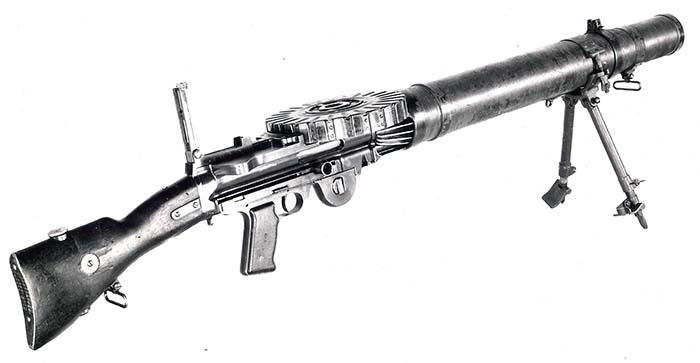
By 1912, Col. Lewis had four hand-made prototypes of his new invention and gave a number of impressive demonstrations to senior army officers. They appeared duly impressed but took no action. On his own initiative he arranged an unofficial demonstration of the weapon being fired from an airplane – the first time this had ever been done. He officially offered his gun to the United States but was rejected by the Army Chief of Ordnance, General Crozier, due primarily, it seems, to a conflict of personalities. This rejection was to haunt General Crozier five years later when the United States entered World War I in 1917 resulting in a number of congressional inquires and accusations. The U.S. had adopted the Automatic Machine Rifle Model of 1909 (Benet-Mercie) in 1909 and had no money for new equipment and, unlike Europe, considered machine guns to be of secondary importance. General Crozier could not be bothered even with this obviously better weapon.
Undaunted, Col. Lewis went to Europe to sell his gun and was enthusiastically received. He helped establish the Armes Automatiques Lewis Company in Liege, Belgium in 1913 to manufacture the Lewis gun on a commercial basis for sale throughout Europe. The British were also extremely interested in the light and efficient weapon particularly since six Lewis guns could be manufactured for the time and expense of making a single Vickers machine gun. License was granted to the Birmingham Small Arms Company (B.S.A.) in Birmingham, England in late 1913. The Armes Automatiques Lewis Company did not produce very many Lewis guns as Belgium was overrun by the Germans in 1914 at the outbreak of World War I. Since B.S.A. was tooled up for production they were able to step in and supply the British and Belgian armies. B.S.A. produced a total of 145,397 Lewis guns during World War I.
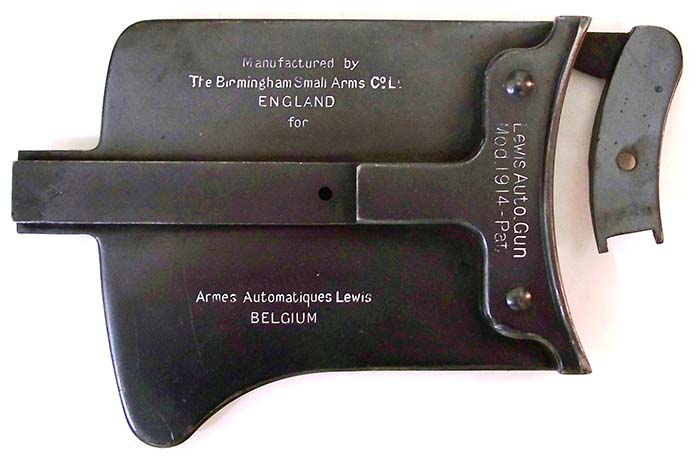
As World War I settled into trench warfare the importance of machine guns became obvious. The Vickers was originally issued two per battalion but it soon became clear that more machine guns (and more flexibility) were needed when the Machine Gun Corps was formed in 1915. To partially fill the gap, four Lewis guns were issued to each battalion. As the war progressed, the Lewis gun proved itself in the rigors of combat in the hands of the British and Belgian soldiers. The greatest asset was the mobility the gun provided. One man could bring fire to bear and quickly move on the attack whereas the Vickers had a five man crew and had to be emplaced. So successful was the use of the Lewis gun that Britain adopted it as a squad level weapon. In addition, the Germans prized the capture of the Lewis gun and used it against the allied forces whenever possible. The German armament industry was geared for the production of the heavy Maxim MG08 machine gun. They didn’t have the time or resources to develop or copy the light machine gun so instead, using existing manufacturing facilities, modified and “lightened” the MG08 into the water-cooled MG08/15 – a heavy and clumsy alternative stop gap measure. There was nothing like the Lewis gun on the battlefield. The French Hotchkiss Portative and its English brother the Hotchkiss Portable Mk1 machine rifle didn’t even come close.
B.S.A. could not keep up with the demand for Lewis guns and contracted with the Savage Arms Company in Utica, New York as an additional supplier. Because of the great success of the Lewis gun in Europe, American proponents pressed for its adoption in the U.S. In 1916, the U.S. Army purchased 350 of the .303 caliber British contract guns from the Savage Arms Company for use by U.S. soldiers in the Mexican boarder war against Poncho Villa. Yet, General Crozier still felt that the Lewis gun was not suitable for adoption. When the United States entered the war in April 1917, the Navy purchased 6,000 guns for issue to the Marine Corps. The Marines trained at great length with the Lewis gun while in the United States, but when sent to France and attached to the 2nd Infantry Division, the Lewis’ were inexplicably taken away and the Marines were issued with the French Chauchat Model 1915 – a decidedly inferior gun. The Army begrudgingly purchased 2,500 guns but used them for training purposes. But it was found that the Lewis gun was perfect for use in aircraft and by the end of the war in 1918 the U.S. Army had purchased 34,000 Lewis aircraft guns.
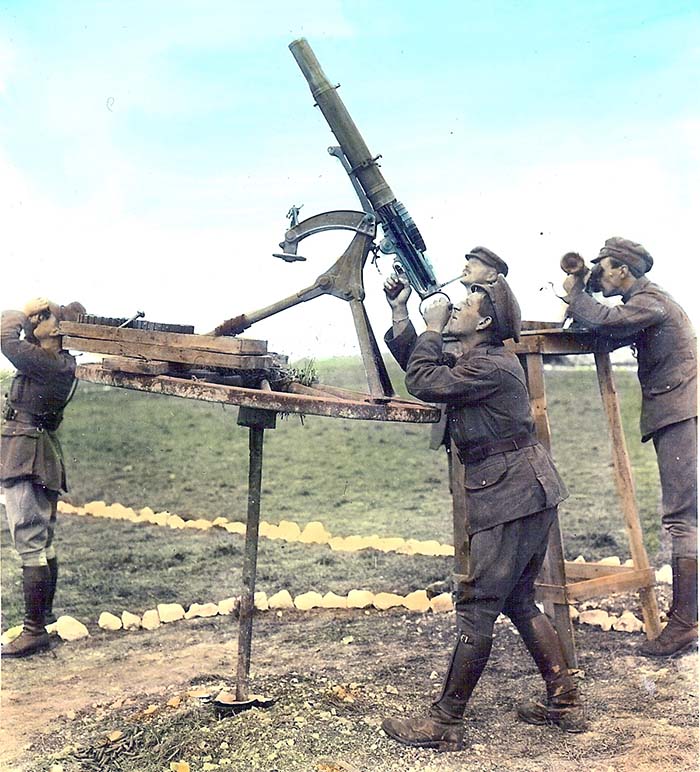
The first use of the Lewis gun in combat was by Belgian forces as they had bought some just prior to the outbreak of the war and would have used them against the invading German army. The very distinctive sound the gun made during firing, due to the barrel jacket extending beyond the muzzle, combined with the delaying combat tactics of the Belgians, earned it the nickname of “Belgian Rattlesnake” by the Germans.
As manufacturing increased both in England and the United States, the British Army greatly increased the number of guns put into action. A British battalion had sixteen platoons in four companies and by 1918 each platoon had two Lewis guns with another four at Battalion Headquarters for anti-aircraft defense.
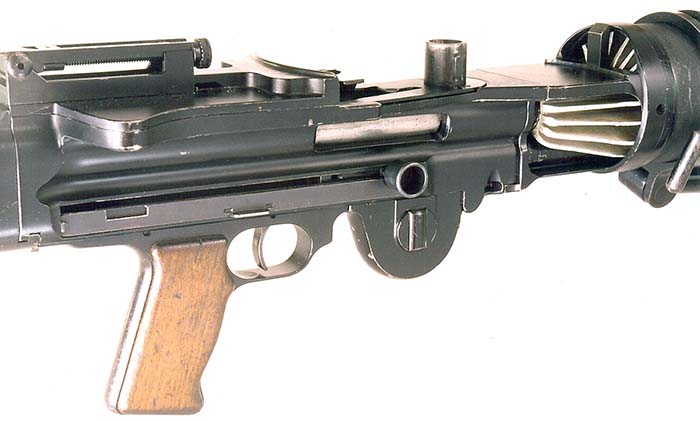
By the end of the war, large scale production ended. Though the gun had many excellent features and characteristics (portable, one man operation, ease of changing pan magazines, resistant to environmental fouling, etc.) it was a complex gun susceptible to a bewildering number of stoppages. There was much room for improvement in the light machine gun category and was ultimately replaced by the Bren gun as standard British issue in 1935. A British Small Arms Training manual dated 1931, Volume II, lists six “immediate action” stoppages and seven possible stoppages for the Lewis gun. The detailing and explanation of the stoppages added up to thirty one pages of small print. Considered obsolete, the Lewis was relegated to a secondary armament role but fortunately a large inventory was on hand. After the debacle at Dunkirk, the Lewis gun once again stepped in to fill the desperate need of the British army to arm trawlers, motor torpedo boats, ground anti-aircraft positions and the Home Guard.
The Lewis gun was officially adopted by Great Britain and widely used by Belgium, France and the United States for ground, air and naval use. The Yokosuka Naval Arsenal in Yokosuka, Japan manufactured copies of the Lewis gun for the Japanese Navy in 1929. Norway also manufactured the Lewis just prior to World War II.
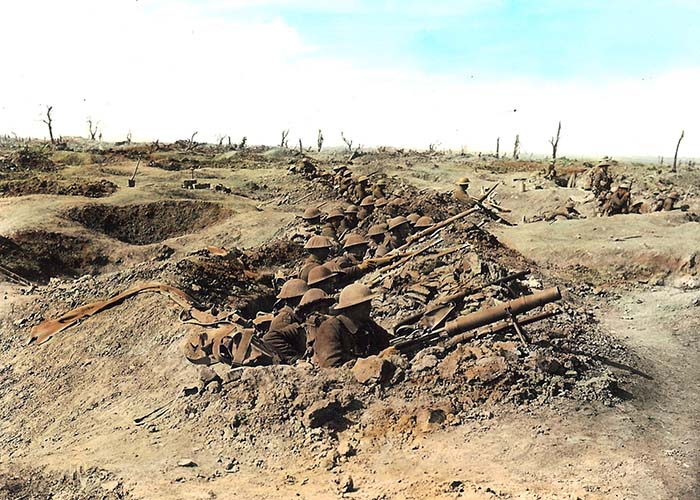
There were a number of accessories for the Lewis gun that included: fold down front anti-aircraft ring sight, rear anti-aircraft sight to mount on top of leaf sight, front and rear illuminated night sights carried in a metal box, pan magazine lever loading tool, post style pan loading tool, metal ammunition chest that carries six pan magazines, canvass pan magazine carrier that holds four magazines, leather gunner’s kit than contains a spare bolt, cocking know, extractor, firing pin, spring, mouthpiece spanner, gas chamber spanner, clearing plug (ruptured case extractor), combination scale for spring tensions measurement with screw driver one end and “bullet point” on the other end for turning the gas key regulator.
The Lewis gun is considered one of the classic machine guns of World War I and is recognized as the first practical light machine gun produced in large quantities used in a large armed conflict. Its distinctive profile, portability and general ease of operation ranks it as the true forerunner of later light machine guns.
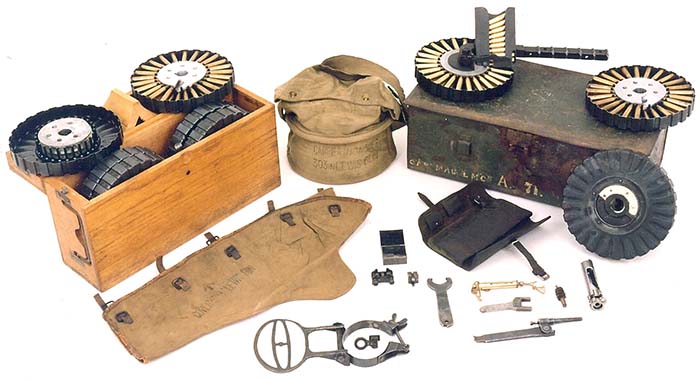
Operation
The primary principle on which the gun worked was gas operation. A small hole was drilled into the barrel. As the bullet traveled past the hole the rapidly expanding gasses behind it would be tapped off from the barrel through the hole into a gas accumulation chamber where it would impinge upon a piston driving it rearward. The piston was connected to an operating rod and bolt. During this rearward movement the bolt would extract the spent cartridge case and eject it through the ejection port to the right rear. A stud located on top of the bolt also engaged a feed arm which engaged and extracted the next round from the double layer, circular pan magazine located on the top of the gun. The mechanism had two stop pawls that ensured that the magazine rotated the correct distance to line up the next cartridge. Additionally, during the rearward movement of the piston, operating rod and bolt, a rack on the underside of the operating rod engaged a pinion which wound a clock-type spring, located just in front of the trigger that would store the energy needed to return the operating parts forward while chambering and firing the next round. The bolt had rotating locking lugs that locked into recesses in the barrel extension and unlocked when high pressure was reduced to a safe level.
The cooling mechanism was unique to the Lewis gun and its actual cooling capabilities versus the added weight have been a source of debate for years. The entire barrel is enclosed in a deeply flanged aluminum radiator casing. The aluminum radiator casing was then enclosed by an outer steel jacket open at both the front and rear to allow air to circulate along the entire length of the finned aluminum casing. Col. Lewis’ theory was that since the steel outer casing projects beyond the end of the muzzle of the barrel, the muzzle blast would cause the air to be sucked in from the rear opening passing along the length of the aluminum radiator casing thus assisting in cooling. This forced draught cooling system has since been proven to be over rated and the gun works quite well without it. The aircraft Lewis gun did away with the aluminum radiator casing and the outer steel casing altogether with no ill effect to operational use.
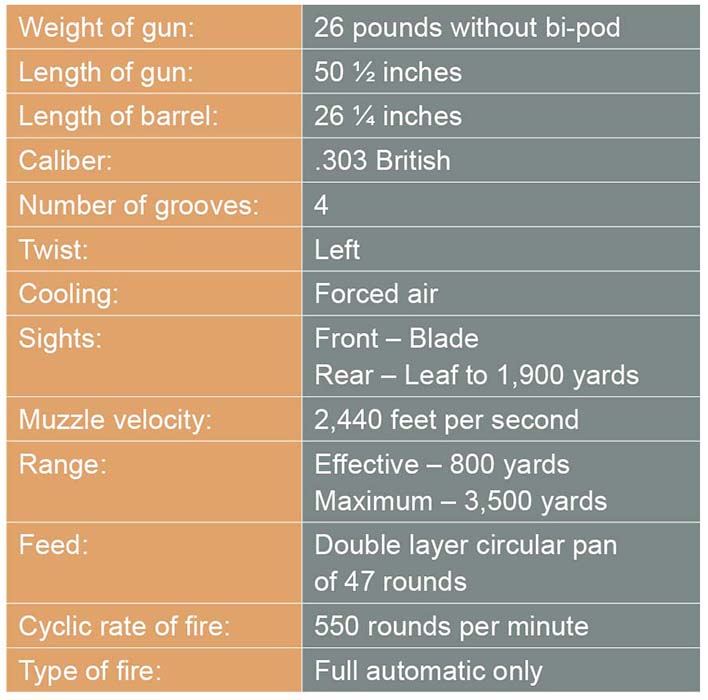
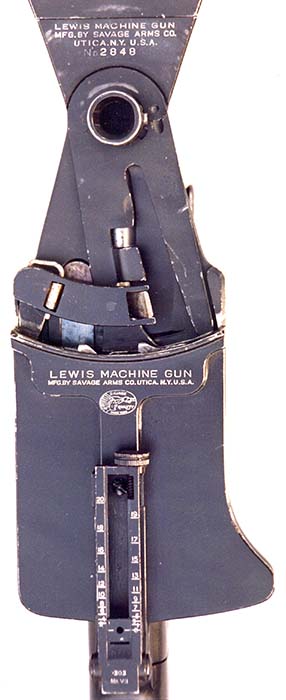
Lewis Gunners
They dwell in a medley of pawls and springs,
Of pinions, and lugs, and racks,
Of cylinders, vents, and various things
Which the average rifle lacks.
My word! How they polish, and oil, and clean,
Ad Nauseam every day,
But you’ll always find them alert and keen –
For that is the gunner’s way.
At night-time they dream the most terrible dreams
Of feed-arms and left-handed screws;
Their slumber with grooved-tailed monstrosities teems
Till they’re nigh in a fit of the blues.
Those number two stoppages haunt them by night,
And also far into the day;
Their remarks would, I’m sure, set asbestos alight –
That is also the gunner’s way.
Up on the fire-step they’ll often be found
Peering earnestly over the top,
Taking mental impressions of all that’s around,
Watching planes, and where Fritz’s shells drop.
On the qui vive for gas, ready for the alarm
At all hours of night or of day;
Alert and intelligent, watchful and calm,
As is always the gunner’s way.
They pound Fritz in gaps which are torn in his wire,
When his gangs are out working at night;
They rake all his trenches with enfilade fire
Till he’s thankful to keep out of sight.
They draw all his fire till the bombers get near,
And pepper him from the next bay,
Then it’s “Kamerade, mercy!” and off to the rear –
That’s the Allemand gunner’s way.
There’s a deadly “Five-nine” that’s a fav’rite of Fritz,
There are glistening Taubes overhead;
There’s a gun and its gunners now shattered to bits,
There are several more names ‘mong the dead.
But their duty is done, as was e’er their proud boast,
For the peace of their souls let us pray:
God rest them, brave lads! For they died at their post –
That is ever the gunner’s way.
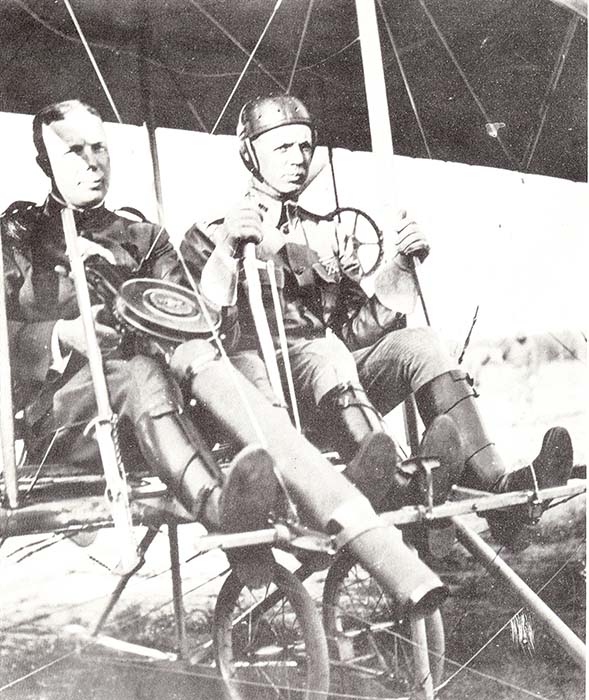
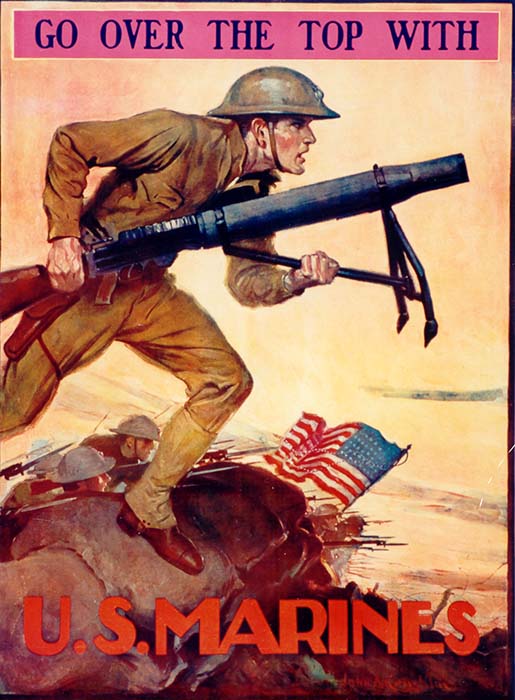
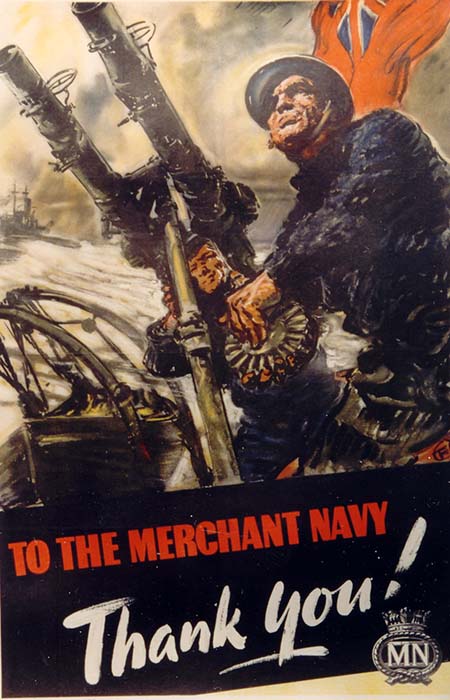
| This article first appeared in Small Arms Review V18N4 (August 2014) |



